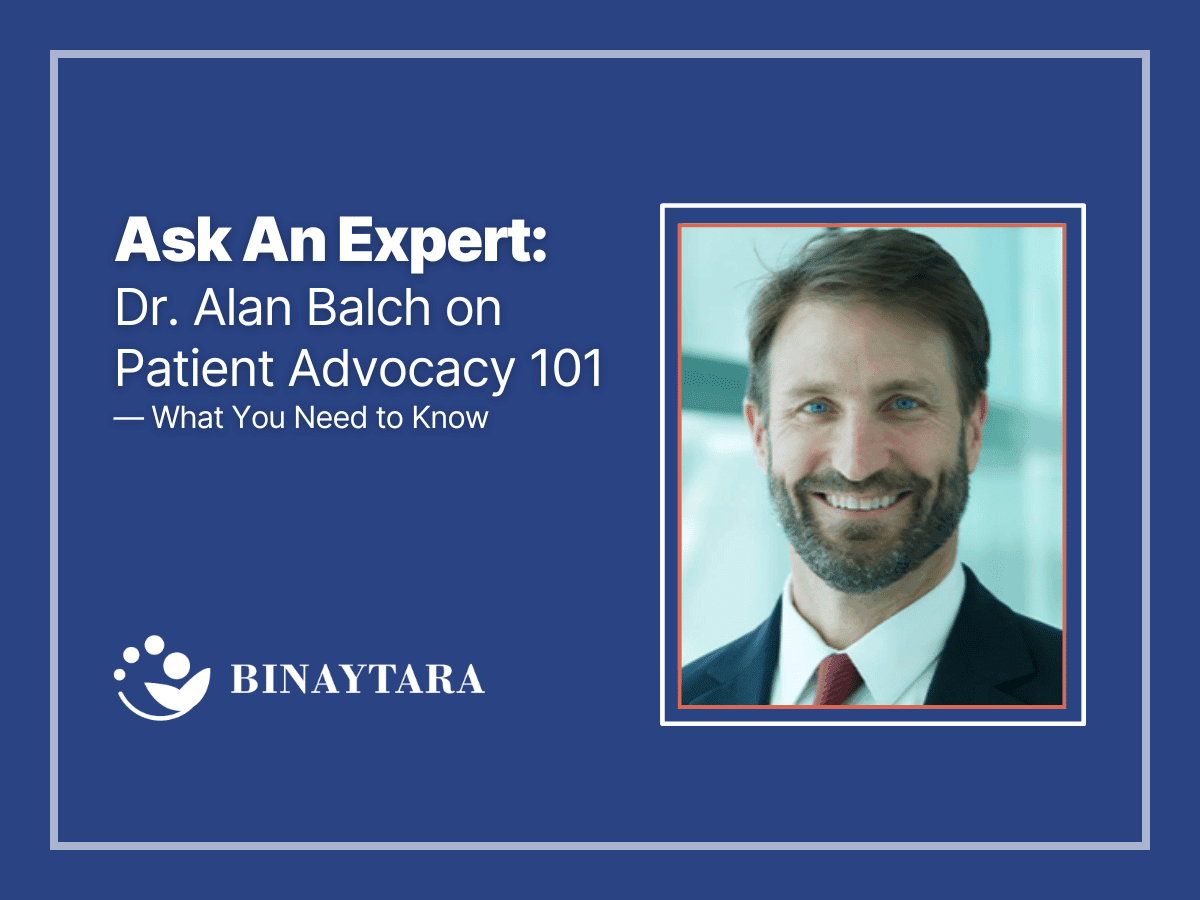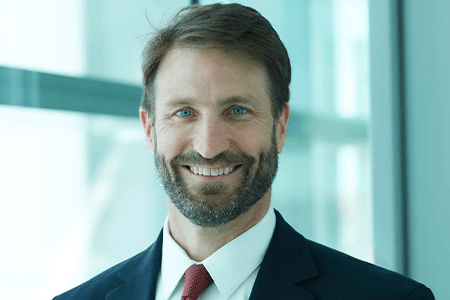Ask an Expert: Dr. Alan Balch on Patient Advocacy 101 — What You Need to Know

Author
Binaytara Team
Introduction
In this interview, Dr. Alan Balch, Chief Executive Officer of the Patient Advocate Foundation, shares key insights into the vital role of patient advocacy in navigating the healthcare system. Wondering who a patient advocate is, when you might need one, or what challenges they can help with? Read the full interview below, where we explore both the basics and the complex, yet promising, field of patient advocacy.
Highlights of the Interview
Introduction to Patient Advocacy
Alan J Balch provided a comprehensive overview of patient advocacy, emphasizing its importance for all patients, not just those with chronic illnesses. He highlighted that navigating the complex healthcare system can be challenging for anyone, and patient advocacy plays a crucial role in helping individuals overcome barriers related to their healthcare journey.
Finding Trustworthy Patient Advocates
The discussion included insights on how to find reliable patient advocates. Balch explained the differences between professional patient advocates, navigators, and social workers. He emphasized the importance of understanding the various roles available within the healthcare system to seek assistance effectively.
Addressing Social Determinants of Health
Balch discussed the growing recognition within the healthcare system of the need to address social determinants of health, such as transportation, housing, and food security. He noted an increasing emphasis on screening for these needs and intervening to provide support for improving patient outcomes. This shift indicates a positive trend towards a more holistic approach to patient care.
The Interview
Question | Binaytara: For those who may not be familiar with your work, can you introduce yourself and share what you do?
Answer| Dr. Alan Balch: “Absolutely. I am Alan Balch, and I serve as CEO of the Patient Advocate Foundation (PAF) as well as the National Patient Advocate Foundation (NPAF). Both organizations work together to serve as a comprehensive healthcare safety net charity.
This means we provide direct support to hundreds of thousands of patients across the country. That support comes in a few different ways. One is through our case management services, where case managers help patients navigate complex healthcare and insurance issues. Another is through financial assistance, which we offer when funding is available, to help patients manage the costs associated with care.
Beyond that, we also focus on health services research and community-based participatory research to better understand patient needs and barriers. We provide educational resources through patient engagement and support groups to empower individuals with the knowledge they need to advocate for themselves.”
Q: You somewhat touched on this. Can you further elaborate on what exactly is patient advocacy?
A: “At its core, patient advocacy is about making sure that your needs and best interests are represented in the healthcare system—whether by you, a loved one, or a professional.
It is about empowering patients to speak up, ask questions, and actively participate in decisions about their care. It also includes those around them—family members, caregivers, and professionals—who can advocate on their behalf.”
Q: Is patient advocacy only for people with cancer or chronic illnesses?
A: “Yeah, I mean, sadly, in a lot of ways we have the world’s best healthcare system, but also in a lot of ways, we have created the world’s most expensive and complicated healthcare system. So, navigating that system takes a lot of knowledge, skill, and time.
Anytime you are a patient—whether it is because you are pregnant, or you have cancer, or you have had a heart attack—whatever it is, when you become a patient in the system, there are parts of it that are going to be hard to understand and that need assistance.
Sometimes people can do it themselves, or have loved ones around them, or caregivers, or support from a professional. But really, it is such a complicated system with so many things that could go wrong that almost everybody could use some advocacy, either on their behalf or from someone else, at some point in their journey in the system.”
Q: What kinds of situations make patient advocacy especially important?
A: “A lot of these are acute problems, right? Just like disease is often a journey of acute issues, so are the barriers that patients face. For example, patients have issues like: I do not know how to get to chemo. Or I went to pick up my prescription, and there was a $400 co-pay. Or I just got this bill in the mail. So there are these crises of the moment that are paralyzing for some individuals, and you really do not know where to go or where to turn.
That is where patient advocacy can become really critical—to just kind of get you over that one immediate barrier that is in front of you. But it is hard to see past it.”
Q: How can someone find a trustworthy patient advocate? Are there differences between advocates in hospitals, nonprofits, and private institutions?
A: “The healthcare system is complicated, and unfortunately, so is the network of support available to patients. Finding the right person to help you can be a journey in itself.
Generally, patient advocates fall into a few categories:
Private professional advocates: These are certified individuals typically hired and paid to advocate on your behalf. They can be very effective but may be costly.
Hospital-based navigators: These include nurse navigators, financial navigators, or social workers who help patients navigate care transitions, access services, and manage logistical barriers. Access may vary depending on the healthcare setting.
Nonprofit or community-based navigators: These roles often focus on helping patients access resources and overcome barriers at no cost. At the Patient Advocate Foundation, for instance, we do not call them “patient advocates” but rather case managers or navigators.
There are also community health workers, usually working outside clinical settings, who help connect patients with care and resources, especially in underserved areas. They are more common in primary care than in specialty fields like oncology.”
Q: What challenges do patients typically face when they reach out to a patient advocate or navigator?
A: “Most problems we encounter start with: 'I can’t afford X.’ That ‘X' could be anything from insurance premiums, copays, and prescriptions to rent, utility bills, or groceries.
We also frequently see:
Transportation issues: Patients may lack access to a vehicle, can’t take time off work, or struggle to pay for gas or parking.
Lack of local resources: Many patients we serve are in community hospitals or smaller practices without financial navigators or social workers.
Our job is to help them identify support, financial or otherwise, and try to remove those barriers or at least alleviate them where we can.”
Q: How do advocates handle cultural and language barriers?
A: “Addressing these barriers takes intentional effort. At our foundation, we: (1) use translation services for phone-based communication. (2) provide cultural competency training for staff. (3) try to 'meet people where they are' to build trust. This is crucial because patients often have to share deeply personal or stigmatizing information. To be effective, we must create an environment where they feel safe and understood. But these same barriers—language, trust, cultural mismatch—can ironically become obstacles to getting help. So we work to remove them proactively.”
Q: What role can patients and caregivers play in advocacy?
A: “Ideally, patients can learn to advocate for themselves, but we recognize that is a lot to ask when someone is already feeling vulnerable. That is why we also support caregivers, who often become the most consistent advocates in a patient’s journey. We try to empower patients and caregivers with tools and training to build confidence and navigate their care or advocate on someone’s behalf.”
Q: Where is the field of patient advocacy heading in the next 5 to 10 years? What policy changes would help?
A: “The healthcare system is beginning to take more responsibility for addressing patients' health-related social needs, like food, housing, and transportation. What is new is not the problem, but the system’s willingness to act on it. Some of the trends we are seeing include:
More routine screening for social needs in healthcare settings.
More responsibility for connecting patients to help after those screenings.
Growing emphasis on trust and proper intervention, since screening without follow-up can do more harm than good.
From a policy standpoint, there is momentum toward reimbursing for navigation services, including through fee-for-service models and value-based care. But for this field to be sustainable, we will need financial models that recognize and support the value of advocacy work in a more permanent, integrated way.”
Conclusion
We hope our interview with Dr. Balch helped answer your questions about patient advocacy and that you feel more empowered to advocate for yourself or your loved ones. As Dr. Balch mentioned, “We often make the mistake of thinking that patient advocacy or navigation is a solution. It's just an intervention.” This interview serves as a reminder that while patient advocacy plays a critical role in assisting individuals, it is not a comprehensive solution to the broader issues within the healthcare system. This is part of what we aim to tackle at the Summit on Cancer Health Disparities (SCHD) taking place in Seattle from April 25 to 27, 2025. Register here to join Dr. Balch and other oncology experts at SCHD25 for cutting-edge discussions that will shape the future of cancer treatment and patient care.
Do you have any burning questions about cancer care or anything related that you would like our experts to address? Feel free to send them here, and we will make sure they are covered in our upcoming discussions!

Dr. Alan J. Balch
About Dr. Alan Balch
Dr. Alan J. Balch is the Chief Executive Officer of the Patient Advocate Foundation (PAF) and the National Patient Advocate Foundation (NPAF). With over two decades of leadership in the nonprofit sector, he has focused on healthcare access, affordability, health equity, and cancer research. Before his role at PAF and NPAF, Dr. Balch served as Vice President of the Preventive Health Partnership and Executive Director of Friends of Cancer Research. He actively contributes to numerous national boards and advisory committees, including the National Academies of Medicine and the National Quality Forum. Dr. Balch also serves on editorial boards for journals such as the Journal of Clinical Pathways and the Journal of Oncology Navigation and Survivorship.